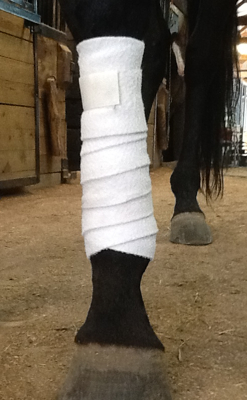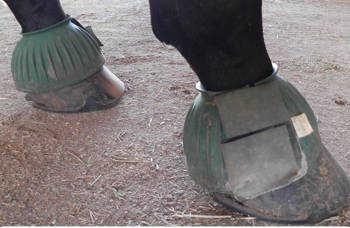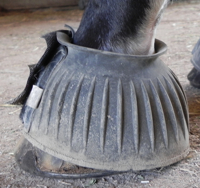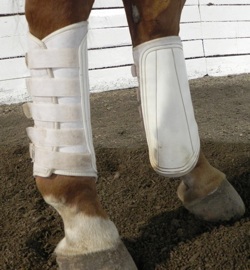
Riders: Protective Equipment
Ah horses. They're always working on
some way to injure themselves, aren't they? You
would think that an animal which evolved to escape
by outrunning predators would be less of a klutz,
but then again, they didn't evolve to carry a
rider, so I guess we can cut them a little bit of
slack. Nonetheless, horses sometimes tangle
up their legs while they're working, and we can
help prevent injuries by judicious use of the
proper protective equipment. Before we go further, it's important
to note that carefully-constructed scientific
trials have shown that no boot can support the
tendons and ligaments in the horse's lower leg. Protect,
yes. Support -- and when we say support,
we basically mean "prevent strained ligaments and
bowed tendons" -- no. Nope. Not gonna happen.
Boots don't support, unless they're so rigid
(think splints and casts) that they immobilize the
horse's leg. And we don't want to ride a horse
with an immobilized leg, do we? Also, recent research warns that the
extreme heat that builds up under protective
equipment when the horse works can actually cause
harm to tendons, so spend a moment deciding if
your horse really needs the protection, or
if you're making him wear protective equipment
because, well, it looks so damned fashionable. But if a horse interferes (the
generic term for hitting one leg with another) we
can provide him with some protection in the form
of boots or bandages. In the dressage department
at William Woods, we'll use either a standard
brushing boot, or properly applied polo bandages.
(Note: I'm speaking for the dressage department
only in this post -- other disciplines might do
things differently, so be sure to check with your
trainer before booting up.) Here's an nice article from TheHorse.com that gives a good overview of protective equipment: Boots and bandages to support and protect.
Bell boots: Bell boots
protect, but don't prevent, a horse from
overreaching -- stepping on his front-leg heels
with the toes of his hind legs. In WWU Dressage
land, we use bell boots on any horse who wears bar
shoes or pads, in a sometimes-futile attempt to
keep the horse from pulling off his shoes. Dressage horses are prone to
missteps as they learn new movements (lateral work
and extended work in particular). Bell boots are
good insurance against the horse injuring himself,
and deciding that this whole dressage thing isn't
really as fun as you had promised.
For dressage work in an indoor
arena, bell boots with hook-and-loop (Velcro)
fasteners are perfectly acceptable, as long as the
hook-and-loop is clean and maintains its
"stick-ability." For more rigorous activities like
jumping and galloping cross country, pull-on bell
boots are more reliable, but much more challenging
to put on. Don't stress too much about the
direction of the hook-and-loop fasteners when you
put on standard bell boots. The boots will turn on
the horse's foot, anyway. If the boots are shaped
to conform to the horse's hoof, they should have a
tag somewhere that indicates "left" and "right."
Brushing boots: We like
brushing boots, because they're easy to put on,
easy to clean, and hard to injure the horse with. There are dozens of styles of
brushing boots (also known as splint boots,
galloping boots, or tendon boots). Spend some time
with any tack catalog, and you'll be amazed at the
variety available -- and you'll be appalled at
some of the prices! The cost of some boots will
tempt you to only use polo bandages. The best brushing boots don't
interfere at all with the horse's movement. They
should be lightweight and thin -- the farther the
boots protrude from the leg, the more likely the
horse is to strike the boot with his swinging leg.
They should also be easy to clean and dry. (For
that reason, I'm not a huge fan of boots with
fuzzy "sheepskin" linings -- they cause the
horse's legs to heat up and sweat, and then take
forever to dry once washed.) For dressage work in arenas, boots
with hook-and-loop closures are sufficient. Make
sure there's no lint and dirt clogging up the
hook-and-loop, or the boots might fall off
at an inopportune moment (and there's never an
opportune moment for boots to fall off!). Brushing boots need be applied only
tight enough to prevent them from slipping down.
Use the contour of the horse's fetlock joint to
keep them in place. The fastener straps should be
on the outside of the leg, and in general,
pointing toward the back. But there are tricky
double-velcro boots that will break that rule, and
you can learn
more about them, and proper boot fitting, on
this page. Polo bandages: Do them right,
or don't do them at all. At the least, a
poorly-applied polo bandage looks unprofessional.
At worst, it can permanently damage the soft
tissues in your horse's lower legs. We dressage people love our polos --
honestly, we just think they look cool, especially
white ones (hot pink, not so much). It's common
practice at dressage shows to wear polos for award
ceremonies, and they're great for showing the
horse's legs in photos and videos. The only way to develop the skill to
apply polo bandages is to practice. And then
practice some more. And then keep practicing.
Eventually, you'll get to know how to bandage a
variety of leg shapes, using a variety of polo
bandages (some shorter, some longer). But you
should never be relaxed and nonchalant when
applying your polos. Be mindful of the correct
procedure, and the dangers inherent in any
bandage, every time you put on a polo bandage.
Need
more info? Here's a page with more on polo
bandages, including a photo comparison of
good and bad bandages.
Heads up!: Don't apply either
boots or bandages to a stocked-up leg. As the
horse begins exercising, the swelling will
dissipate, and the boot or bandage will loosen,
which can be very dangerous. If you want to use
protective equipment on a horse who has stocked
up, walk him (under saddle or in hand) for about
15 minutes, and then apply the boot or bandage
after the swelling has subsided. The photo at right is of a
stocked-up leg. Note the lack of definition in the
cannon bone and fetlock joint. Because horses have
poor lower-leg circulation unless they're moving,
stocking up is not unusual in a horse who spends
most of his time confined to a stall. If the
swelling is soft, lacks heat, and goes away with
15-20 minutes of activity, it's probably nothing
to worry about -- unless you put a boot or bandage
on the fat leg, which then gets loose, unravels,
tangles up in your horse's legs, and causes him to
trip, fall and catapult you into the arena wall.
Then it's something to worry about! Competition rules: Protective
equipment is legal for warm up at all dressage
competitions, but is NOT legal in the show
ring. Wearing boots or bandages into the show
arena will result in elimination. Make sure you
have someone standing by, ready to remove your
protective equipment before you head down the
centerline! Some of the content of this post was taken from the upcoming iBook "The Bandage Book" by Karen Pautz. Once it's on iTunes, I'll post about it! |
|
|
| Copyright 1996-2014, Karen Pautz. All rights reserved. |




